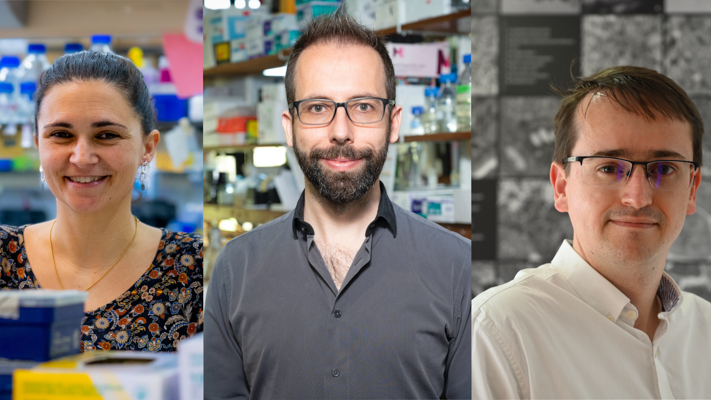Researchers receive grant from the Chan Zuckerberg Initiative
Four researchers from three COLife institutes have been awarded nearly €1M under the Chan Zuckerberg Initiative’s Measuring Metabolism Across Scales program. Zita Carvalho-Santos at the Instituto de Medicina Molecular João Lobo Antunes (iMM) and Ricardo Henriques and Jorge Carvalho at the Gulbenkian Institute of Science (IGC), together with Carlos Ribeiro at the Champalimaud Foundation (CF) and Theodore Alxandrow at the European Molecular Biology Laboratory (EMBL), have garnered grants to conduct pioneering projects in the field of metabolism.
The Chan Zuckerberg Initiative (CZI) program aims to accelerate cutting-edge research and technology in metabolism and metabolic physiology through these two-year collaborative research grants. These grants aim to map, measure, and integrate metabolism across different scales—from molecules and organelles to cells and tissues—deepening our understanding of human biology and investigating the metabolic processes that maintain physiological homeostasis.
The research conducted by these scientists will not only expand the scientific knowledge base but also pave the way for future research initiatives that could ultimately inform treatments and cures for a wide range of diseases. Listed below is more information about the awardees and their projects.
Zita Carvalho-Santos (iMM), Ricardo Henriques (IGC) & Jorge Carvalho (IGC)
Sub-cellular Metabolic Compartmentalization during Oocyte Development

Zita Carvalho-Santos at the Instituto de Medicina Molecular João Lobo Antunes (iMM), Ricardo Henriques and Jorge Carvalho at the Gulbenkian Institute of Science (IGC).
Zita Carvalho-Santos, group leader at the Instituto de Medicina Molecular João Lobo Antunes, along with Ricardo Henriques and Jorge Carvalho, from the Instituto Gulbenkian de Ciência, will lead a project set to explore the organization of cellular metabolism during oocyte development. This groundbreaking project promises to unravel fundamental biological phenomena and is critical for understanding how cellular metabolism impacts cellular functions in both physiological and disease settings.
“All organisms, whether bacteria, plants, fungi, or animals, are composed of the same functional units – cells. Cells are kept alive by the constant production of building blocks and energy, which result from complex transformations involving metabolic processes. Each of these processes has different metabolic requirements. How are these processes efficiently fueled? I believe the answer lies in the compartmentalization of metabolic functions” – says Zita Carvalho-Santos, when questioned about the scientific drive for this research project.
Metabolic processes are likely set in specific parts of the cell for a higher efficiency of cellular processes. This effect is particularly relevant in larger cells, with the largest cell in the animal body being the oocyte, the focus of this research. The details of which metabolic processes are localized in which parts of the cell, how this spatial distribution is regulated, and what functional significance it holds remain far from fully understood.
“This project encompasses an interdisciplinary approach and know-how in cell biology, biochemistry, advanced microscopy, microfluidics, and computational science. It will contribute to understanding metabolism across scales by mapping the spatial and temporal impact on cellular processes of the metabolon-cytoskeleton dynamics during the exciting process of oogenesis”, adds Jorge Carvalho, also a winning team member, on the methodology and multidisciplinarity of the project.
To Ricardo Henriques, “Being a part of this collaborative project is truly exciting for me as it opens up new avenues for developing groundbreaking technologies to help researchers see the inner workings of cells with better clarity. Our team specializes in advanced microscopy techniques that can capture high-resolution pictures of the molecules and structures within cells. By deploying these cutting-edge techniques in this project, we aim to create a detailed map of the location of metabolic enzymes within oocyte cells. The potential of these technologies to be adapted by other scientists for studying biological systems and processes inside cells is immense”. And looking to the future, Henriques adds he is “thrilled to see how these new methods for capturing metabolism at the molecular level will pave the way for many exciting scientific discoveries in the future”.
Theodore Alxandrow (EMBL) & Carlos Ribeiro (CF)
Mapping fatty acid synthesis in an entire organism, in space and time
In collaboration with Theodore Alxandrow at EMBL, Carlos Ribeiro, a Principal Investigator at the CF, is spearheading a project that aims to revolutionize our understanding of fatty acid metabolism in animals and how it responds to biological and environmental changes.
The research will employ a novel spatial metabolomics approach to generate atlases that visually represent changes in fatty acid metabolism within whole animals. This could provide unprecedented insights into the role of the metabolic organization in maintaining homeostasis, the body’s internal equilibrium. “The ability to see where fatty acid metabolism changes in a whole animal excites me the most”, says Ribeiro. “This knowledge would give us a deeper understanding of how environmental factors, such as climate change, affect the metabolism of insects, which are crucial for global homeostasis and human well-being”.
The key challenge is to pinpoint exactly where metabolic changes occur within an organism. Current technologies allow researchers to identify how metabolites change in response to dietary, microbiome, or environmental modifications, but they fall short of revealing the locations of these changes. “The method we will develop and validate and use in flies will allow us to overcome this challenge”, Ribeiro notes.
By unveiling the spatial organization of fatty acid metabolism, the project would fill an important gap in our current understanding of how environmental, lifestyle and pathological conditions impact metabolic homeostasis. This, in turn, could offer more comprehensive insights into health and diseases, particularly those conditions where metabolic dysregulation plays a pivotal role. Furthermore, environmental fluctuations, including temperature variations, can also affect insect homeostasis, thereby potentially exacerbating the impact of climate change.
The project unites Theodore Alxandrow’s EMBL laboratory, specialized in the development of spatial metabolomics technologies, with Carlos Ribeiro’s laboratory, which possesses extensive expertise in investigating the effects of diet, microbiome, and environmental changes on whole-animal metabolism. According to Ribeiro, “Pairing technological expertise with ambitious biological questions is the best way to break new grounds”.
